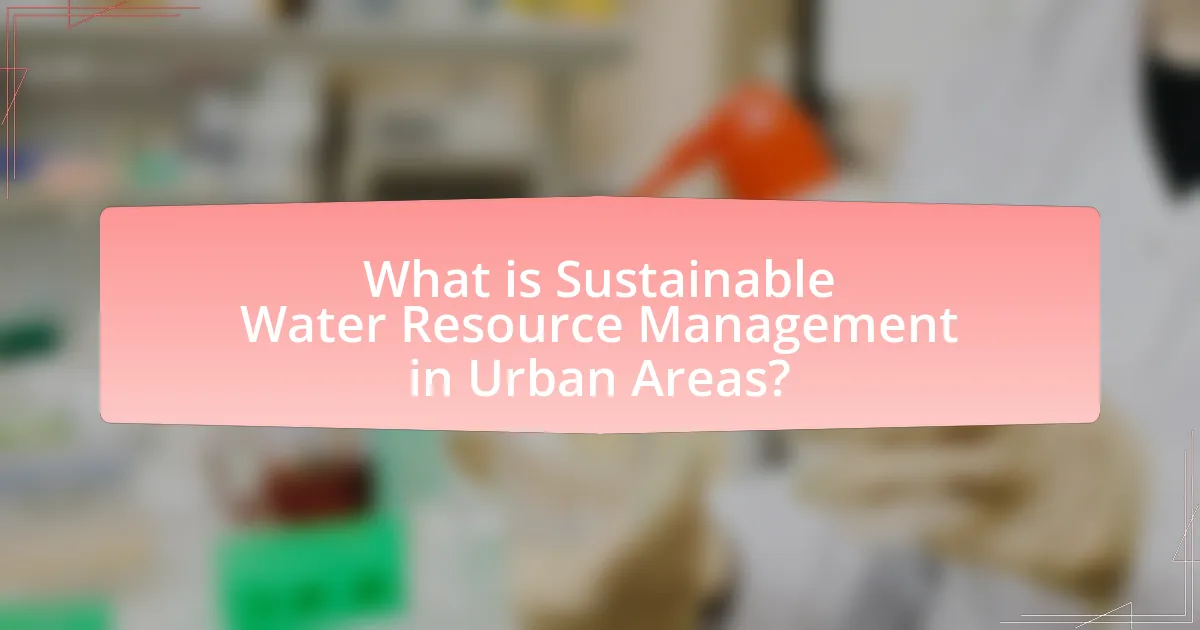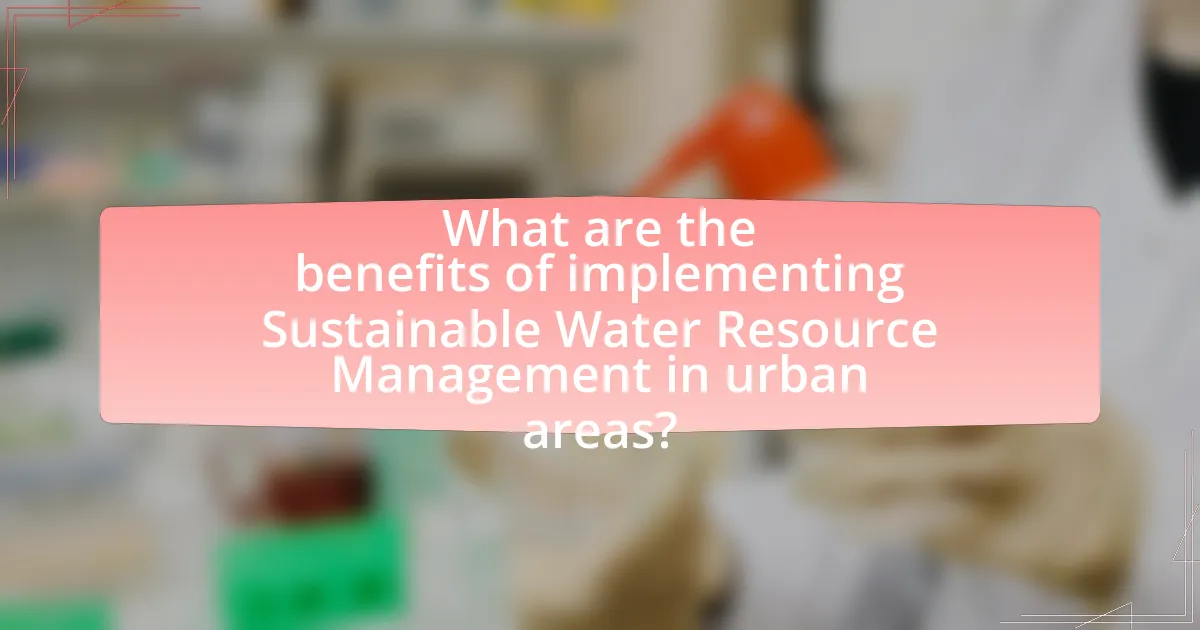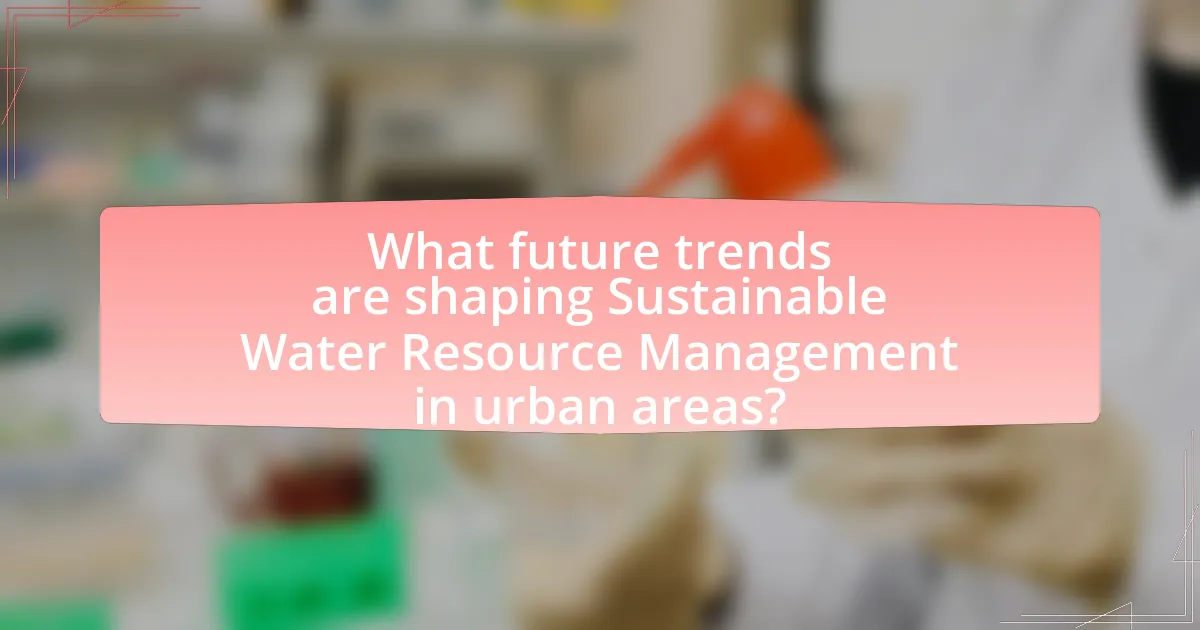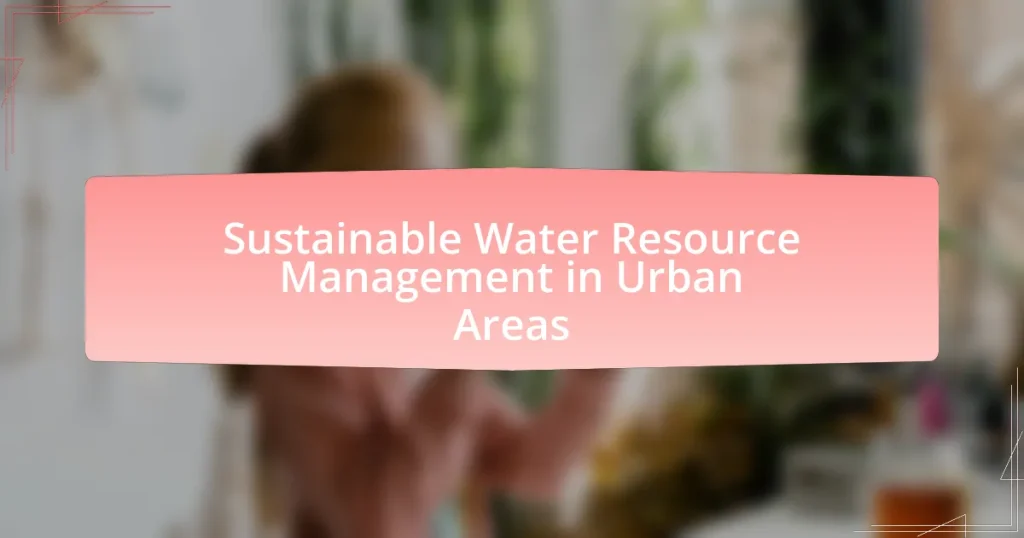Sustainable Water Resource Management in Urban Areas is a strategic approach aimed at efficiently managing water resources to meet current and future urban demands while ensuring environmental protection and social equity. The article outlines the differences between sustainable and traditional water management, emphasizing the importance of practices such as rainwater harvesting, wastewater recycling, and green infrastructure. It discusses the challenges urban areas face, including population growth, pollution, and climate change, and highlights key principles and strategies for effective management. Additionally, the article examines the role of community involvement, technology, and policies in promoting sustainable practices, ultimately demonstrating the benefits of implementing these strategies for improved water quality, urban resilience, and biodiversity conservation.

What is Sustainable Water Resource Management in Urban Areas?
Sustainable Water Resource Management in Urban Areas refers to the strategic approach of managing water resources to meet current and future urban needs while ensuring environmental protection and social equity. This management includes practices such as rainwater harvesting, wastewater recycling, and the implementation of green infrastructure to enhance water quality and availability. According to the United Nations, urban areas are projected to house 68% of the global population by 2050, making effective water management crucial to support this growth sustainably.
How does Sustainable Water Resource Management differ from traditional water management?
Sustainable Water Resource Management (SWRM) focuses on the long-term viability and ecological balance of water resources, while traditional water management primarily emphasizes short-term supply and demand. SWRM incorporates practices such as water conservation, ecosystem protection, and stakeholder engagement to ensure that water resources are used efficiently and equitably, addressing both current and future needs. In contrast, traditional water management often relies on infrastructure development and centralized control, which can lead to over-extraction and environmental degradation. For example, studies show that cities implementing SWRM strategies, like green infrastructure and rainwater harvesting, experience improved water quality and reduced flood risks, demonstrating the effectiveness of sustainable practices over conventional methods.
What are the key principles of Sustainable Water Resource Management?
The key principles of Sustainable Water Resource Management include integrated management, stakeholder participation, and adaptive management. Integrated management emphasizes the holistic approach to water resources, considering the interconnections between water, land, and ecosystems. Stakeholder participation ensures that all relevant parties, including communities and industries, are involved in decision-making processes, which enhances transparency and accountability. Adaptive management allows for flexibility and responsiveness to changing conditions and new information, ensuring that strategies remain effective over time. These principles are supported by frameworks such as the Integrated Water Resources Management (IWRM) approach, which has been endorsed by organizations like the United Nations, highlighting their importance in achieving sustainable water management.
Why is Sustainable Water Resource Management important for urban areas?
Sustainable Water Resource Management is crucial for urban areas because it ensures the availability and quality of water resources while minimizing environmental impacts. Urban areas face challenges such as population growth, increased water demand, and pollution, which can lead to water scarcity and degradation of water quality. Effective management practices, such as rainwater harvesting and wastewater recycling, can enhance water supply resilience and reduce reliance on external sources. According to the United Nations, by 2050, nearly 68% of the world’s population is projected to live in urban areas, intensifying the need for sustainable practices to secure water resources for future generations.
What challenges do urban areas face in water resource management?
Urban areas face significant challenges in water resource management, including population growth, pollution, infrastructure deterioration, and climate change. Rapid population growth leads to increased water demand, often outpacing supply and straining existing systems. Pollution from industrial and residential sources contaminates water supplies, complicating treatment processes and increasing costs. Aging infrastructure, such as pipes and treatment plants, results in leaks and inefficiencies, contributing to water loss. Additionally, climate change exacerbates water scarcity through altered precipitation patterns and increased frequency of extreme weather events, making it difficult for urban planners to ensure sustainable water availability. These factors collectively hinder effective water resource management in urban settings.
How do population growth and urbanization impact water resources?
Population growth and urbanization significantly strain water resources by increasing demand and altering natural water cycles. As urban populations expand, the need for potable water rises, leading to over-extraction from rivers, lakes, and aquifers. For instance, the United Nations projects that by 2050, nearly 68% of the global population will live in urban areas, intensifying competition for limited water supplies. Additionally, urbanization often leads to increased impervious surfaces, which disrupt natural water infiltration and reduce groundwater recharge, exacerbating water scarcity. Studies indicate that cities consume up to 75% of the world’s freshwater resources, highlighting the urgent need for sustainable management practices to address these challenges effectively.
What role does climate change play in urban water management challenges?
Climate change significantly exacerbates urban water management challenges by altering precipitation patterns, increasing the frequency of extreme weather events, and raising temperatures. These changes lead to more intense rainfall and flooding, which overwhelm existing drainage systems, while prolonged droughts strain water supply sources. For instance, a study by the Intergovernmental Panel on Climate Change (IPCC) indicates that urban areas are particularly vulnerable to flooding due to climate change, with projected increases in heavy precipitation events. Additionally, rising temperatures can increase evaporation rates, further reducing available water resources. This combination of factors complicates the planning and management of urban water systems, necessitating adaptive strategies to ensure sustainable water resource management in cities.
What strategies are employed in Sustainable Water Resource Management?
Sustainable Water Resource Management employs strategies such as integrated water resource management (IWRM), water conservation practices, and the use of green infrastructure. IWRM focuses on the coordinated development and management of water, land, and related resources to maximize economic and social welfare without compromising the sustainability of vital ecosystems. Water conservation practices, including rainwater harvesting and wastewater recycling, significantly reduce demand on freshwater sources. Green infrastructure, such as permeable pavements and green roofs, enhances stormwater management and improves water quality by mimicking natural hydrological processes. These strategies collectively aim to ensure the long-term availability and quality of water resources in urban areas.
How can rainwater harvesting contribute to sustainable practices?
Rainwater harvesting contributes to sustainable practices by efficiently collecting and utilizing rainwater, thereby reducing dependence on conventional water sources. This method mitigates urban flooding, decreases stormwater runoff, and conserves potable water, which is crucial in areas facing water scarcity. According to the United Nations, rainwater harvesting can reduce water demand by up to 50% in urban settings, promoting sustainable water management. Additionally, it enhances groundwater recharge, which is vital for maintaining local ecosystems and ensuring long-term water availability.
What is the significance of wastewater recycling in urban settings?
Wastewater recycling is significant in urban settings as it provides a sustainable solution to water scarcity and enhances water resource management. Urban areas often face high water demand due to population density and industrial activities, leading to increased pressure on freshwater sources. By recycling wastewater, cities can reduce their reliance on these sources, thereby conserving them. For instance, the United Nations estimates that by 2030, global water demand will exceed supply by 40%, highlighting the urgent need for effective wastewater management strategies. Furthermore, recycled wastewater can be used for non-potable purposes such as irrigation, industrial processes, and toilet flushing, which can significantly lower overall water consumption in urban environments.
How can community involvement enhance Sustainable Water Resource Management?
Community involvement enhances Sustainable Water Resource Management by fostering local stewardship and promoting collaborative decision-making. Engaging residents in water management initiatives leads to increased awareness of water conservation practices, as evidenced by studies showing that communities with active participation in water programs reduce water usage by up to 20%. Furthermore, local input can help identify specific water-related challenges and solutions, ensuring that management strategies are tailored to the unique needs of the community. This participatory approach not only improves the effectiveness of water management policies but also builds a sense of ownership and responsibility among community members, ultimately leading to more sustainable water practices.
What are effective ways to engage the community in water conservation efforts?
Effective ways to engage the community in water conservation efforts include organizing educational workshops, implementing community challenges, and utilizing social media campaigns. Educational workshops provide residents with knowledge about water-saving techniques, such as rainwater harvesting and xeriscaping, which can lead to behavioral changes. Community challenges, like “Water-Wise Month,” encourage participation by rewarding households that reduce water usage, fostering a sense of competition and community spirit. Social media campaigns can raise awareness and share success stories, reaching a broader audience and motivating individuals to adopt water-saving practices. These methods have been shown to increase community involvement and awareness, leading to measurable reductions in water consumption.
How does public awareness influence water management practices?
Public awareness significantly influences water management practices by fostering community engagement and promoting sustainable behaviors. When the public is informed about water scarcity and the importance of conservation, they are more likely to adopt practices such as reducing water waste and supporting policies aimed at sustainable water use. For instance, studies have shown that educational campaigns can lead to a 20-30% reduction in residential water consumption during drought periods. Additionally, increased public awareness can drive demand for better infrastructure and policies, as communities advocate for investments in water-efficient technologies and practices. This collective action can result in more effective water management strategies that align with sustainability goals in urban areas.

What are the benefits of implementing Sustainable Water Resource Management in urban areas?
Implementing Sustainable Water Resource Management in urban areas leads to improved water quality and reduced environmental impact. This approach minimizes water wastage through efficient usage and promotes the recycling of water, which is crucial in densely populated regions. For instance, cities that adopt rainwater harvesting and greywater recycling can significantly decrease their reliance on freshwater sources, thereby conserving them. According to the United Nations, sustainable water management can reduce urban water demand by up to 30%, enhancing resilience against climate change and ensuring a stable water supply for future generations.
How does Sustainable Water Resource Management improve urban resilience?
Sustainable Water Resource Management enhances urban resilience by ensuring a reliable supply of water while minimizing environmental impacts. This approach incorporates practices such as rainwater harvesting, wastewater recycling, and the preservation of natural water bodies, which collectively reduce vulnerability to water scarcity and flooding. For instance, cities that implement green infrastructure, like permeable pavements and green roofs, can effectively manage stormwater, thereby decreasing the risk of urban flooding. Research indicates that cities employing sustainable water management strategies can experience up to a 30% reduction in flood-related damages, demonstrating the effectiveness of these practices in bolstering urban resilience.
What economic benefits arise from sustainable water practices?
Sustainable water practices yield significant economic benefits, including cost savings, increased property values, and enhanced resilience to climate change. By implementing efficient water management systems, municipalities can reduce water treatment and supply costs, leading to savings that can be redirected to other essential services. For instance, cities that invest in green infrastructure, such as rain gardens and permeable pavements, often see a decrease in stormwater management costs by up to 30%. Additionally, properties located in areas with sustainable water practices typically experience higher market values, as buyers increasingly prioritize environmental sustainability. Furthermore, sustainable water practices contribute to economic resilience by mitigating the impacts of droughts and floods, which can otherwise lead to substantial economic losses. Studies indicate that every dollar invested in water conservation can yield up to $4 in economic returns, demonstrating the financial viability of sustainable water management strategies.
How does it enhance the quality of life for urban residents?
Sustainable water resource management enhances the quality of life for urban residents by ensuring reliable access to clean water, which is essential for health and well-being. Effective management practices reduce water scarcity, mitigate flooding, and improve water quality, leading to healthier communities. For instance, cities that implement green infrastructure, such as rain gardens and permeable pavements, can significantly decrease stormwater runoff, thereby reducing pollution in local water bodies. According to the U.S. Environmental Protection Agency, such practices can lead to a 30% reduction in urban flooding, directly benefiting residents by minimizing property damage and enhancing public safety.
What environmental impacts can be mitigated through Sustainable Water Resource Management?
Sustainable Water Resource Management can mitigate several environmental impacts, including water scarcity, pollution, and habitat degradation. By implementing practices such as rainwater harvesting, wastewater recycling, and efficient irrigation, urban areas can reduce the demand on freshwater sources, thereby alleviating water scarcity. Additionally, these practices help minimize the runoff of pollutants into local waterways, which is crucial for maintaining water quality. For instance, the use of green infrastructure, like permeable pavements and green roofs, can enhance stormwater management and reduce urban flooding, further protecting aquatic habitats. Studies indicate that cities employing sustainable water management strategies can see a significant decrease in water-related environmental issues, promoting overall ecosystem health.
How does it contribute to biodiversity conservation in urban areas?
Sustainable water resource management in urban areas contributes to biodiversity conservation by creating habitats that support various species. For instance, the implementation of green infrastructure, such as rain gardens and permeable pavements, enhances water retention and filtration, which in turn fosters diverse plant and animal life. Research indicates that urban green spaces can increase species richness by up to 30%, providing essential ecosystems for pollinators and other wildlife. Additionally, effective stormwater management reduces pollution runoff, protecting aquatic ecosystems and promoting healthier biodiversity in urban waterways.
What role does it play in reducing urban flooding risks?
Sustainable water resource management plays a crucial role in reducing urban flooding risks by implementing strategies that enhance water absorption and drainage in urban environments. These strategies include the creation of green infrastructure, such as permeable pavements and green roofs, which allow rainwater to infiltrate the ground rather than overwhelming drainage systems. According to the U.S. Environmental Protection Agency, green infrastructure can reduce stormwater runoff by 30-50%, significantly mitigating the risk of flooding during heavy rainfall events. Additionally, effective management practices, such as rainwater harvesting and the restoration of natural waterways, further contribute to flood risk reduction by improving the overall resilience of urban areas to extreme weather conditions.
What are the best practices for implementing Sustainable Water Resource Management?
The best practices for implementing Sustainable Water Resource Management include integrated planning, stakeholder engagement, and the adoption of innovative technologies. Integrated planning ensures that water management is coordinated across various sectors, addressing the interdependencies between water supply, sanitation, and land use. Stakeholder engagement involves involving local communities, government agencies, and private sectors in decision-making processes, which enhances transparency and accountability. The adoption of innovative technologies, such as smart water meters and rainwater harvesting systems, improves efficiency and reduces waste. These practices are supported by the United Nations’ Sustainable Development Goals, which emphasize the importance of sustainable water management for urban resilience and environmental sustainability.
How can cities effectively integrate green infrastructure in water management?
Cities can effectively integrate green infrastructure in water management by implementing systems such as green roofs, permeable pavements, and rain gardens that enhance stormwater management and reduce runoff. These solutions allow for natural absorption and filtration of rainwater, which mitigates flooding and improves water quality. For instance, a study by the U.S. Environmental Protection Agency found that green infrastructure can reduce stormwater runoff by 30-50%, demonstrating its effectiveness in urban settings. Additionally, cities can promote community engagement and collaboration with local stakeholders to design and maintain these green spaces, ensuring their long-term success and sustainability.
What policies support the adoption of sustainable water practices?
Policies that support the adoption of sustainable water practices include regulations promoting water conservation, incentives for green infrastructure, and frameworks for integrated water resource management. For instance, the Clean Water State Revolving Fund provides financial assistance for projects that improve water quality and promote sustainable practices. Additionally, local governments often implement water pricing strategies that encourage efficient use and conservation, as seen in cities like San Francisco, which has adopted tiered water rates to reduce consumption. These policies are designed to enhance water efficiency, protect ecosystems, and ensure long-term water availability in urban areas.

What future trends are shaping Sustainable Water Resource Management in urban areas?
Future trends shaping Sustainable Water Resource Management in urban areas include the adoption of smart water technologies, integrated water management approaches, and increased emphasis on water reuse and recycling. Smart water technologies, such as IoT sensors and data analytics, enable real-time monitoring and management of water systems, improving efficiency and reducing waste. Integrated water management approaches promote collaboration among various stakeholders, ensuring that water resources are managed holistically. Additionally, the focus on water reuse and recycling is driven by the need to address water scarcity, with cities implementing systems to treat and repurpose wastewater for non-potable uses. These trends are supported by global initiatives aimed at sustainable development, such as the United Nations Sustainable Development Goals, which emphasize the importance of clean water and sustainable management practices.
How is technology influencing water resource management strategies?
Technology is significantly influencing water resource management strategies by enhancing data collection, analysis, and decision-making processes. Advanced technologies such as remote sensing, geographic information systems (GIS), and IoT sensors enable real-time monitoring of water quality and quantity, allowing for more efficient allocation and usage of water resources. For instance, a study by the World Bank in 2020 highlighted that cities implementing smart water management systems reduced water loss by up to 30%, demonstrating the effectiveness of technology in optimizing water distribution and minimizing waste. Additionally, predictive analytics powered by machine learning can forecast water demand and supply fluctuations, aiding urban planners in developing sustainable water management policies.
What innovations are emerging in water conservation technologies?
Emerging innovations in water conservation technologies include smart irrigation systems, rainwater harvesting, and advanced water recycling methods. Smart irrigation systems utilize sensors and data analytics to optimize water usage in agriculture and landscaping, significantly reducing waste. Rainwater harvesting technologies capture and store rainwater for non-potable uses, which can decrease reliance on municipal water supplies. Advanced water recycling methods, such as membrane bioreactors and reverse osmosis, enable the treatment and reuse of wastewater, contributing to sustainable urban water management. These innovations collectively enhance water efficiency and sustainability in urban areas.
How can data analytics improve decision-making in water management?
Data analytics can significantly improve decision-making in water management by providing actionable insights derived from large datasets. By analyzing historical water usage patterns, weather data, and population growth trends, water management authorities can forecast demand more accurately and optimize resource allocation. For instance, a study by the American Water Works Association found that utilities using data analytics reduced water loss by up to 30% through better leak detection and maintenance scheduling. This data-driven approach enables proactive management, enhances efficiency, and supports sustainable practices in urban water resource management.
What role do policies and regulations play in advancing sustainable practices?
Policies and regulations are crucial in advancing sustainable practices by establishing frameworks that guide behavior and decision-making in resource management. These legal instruments set standards for water usage, pollution control, and conservation efforts, ensuring that urban areas adhere to sustainability goals. For instance, the Clean Water Act in the United States mandates the regulation of discharges into water bodies, promoting practices that protect water quality and ecosystems. Additionally, regulations can incentivize the adoption of green infrastructure, such as rain gardens and permeable pavements, which enhance water management and reduce runoff. By enforcing compliance and providing guidelines, policies and regulations effectively drive the transition towards sustainable water resource management in urban settings.
How can governments incentivize sustainable water management initiatives?
Governments can incentivize sustainable water management initiatives by implementing financial incentives such as grants, subsidies, and tax breaks for projects that promote water conservation and efficiency. For example, the U.S. Environmental Protection Agency has provided funding through the Clean Water State Revolving Fund, which supports local governments in developing sustainable water infrastructure. Additionally, governments can establish regulations that require water-efficient practices, thereby encouraging businesses and households to adopt technologies that reduce water usage. Studies show that regions with such incentives experience a significant reduction in water consumption, highlighting the effectiveness of these measures in promoting sustainable practices.
What international frameworks support urban water sustainability?
International frameworks that support urban water sustainability include the United Nations Sustainable Development Goals (SDGs), particularly Goal 6, which aims to ensure availability and sustainable management of water and sanitation for all. Additionally, the World Health Organization (WHO) provides guidelines for drinking-water quality, which promote safe and sustainable water practices in urban settings. The Ramsar Convention on Wetlands also emphasizes the importance of sustainable water management in urban areas by protecting wetlands that play a crucial role in water purification and flood control. These frameworks collectively guide policies and practices that enhance urban water sustainability globally.
What practical steps can urban planners take to promote Sustainable Water Resource Management?
Urban planners can promote Sustainable Water Resource Management by implementing integrated water management strategies that prioritize conservation, efficiency, and ecosystem health. These strategies include the development of green infrastructure, such as rain gardens and permeable pavements, which enhance stormwater management and reduce runoff. Additionally, planners can enforce regulations that require water-efficient fixtures in new developments, thereby reducing overall water consumption.
Evidence from the U.S. Environmental Protection Agency indicates that green infrastructure can reduce urban flooding by up to 30%, demonstrating its effectiveness in managing water resources sustainably. Furthermore, urban planners can engage in community education programs to raise awareness about water conservation practices, which can lead to behavioral changes that support sustainable water use.
How can urban designs incorporate sustainable water practices effectively?
Urban designs can effectively incorporate sustainable water practices by integrating green infrastructure, such as rain gardens, permeable pavements, and green roofs, which facilitate natural water absorption and reduce runoff. These elements enhance stormwater management by allowing rainwater to infiltrate the ground, thus replenishing groundwater supplies and minimizing flooding risks. For instance, cities like Portland, Oregon, have successfully implemented green streets that utilize bioswales to manage stormwater, resulting in a 30% reduction in runoff. Additionally, the use of reclaimed water for irrigation and non-potable applications further promotes water conservation, as demonstrated by the city of San Diego’s recycled water program, which supplies over 30 million gallons of recycled water daily.
What are the key considerations for future urban water management projects?
Key considerations for future urban water management projects include integrated planning, climate resilience, and stakeholder engagement. Integrated planning ensures that water management aligns with land use, transportation, and environmental policies, promoting efficient resource use. Climate resilience is critical as urban areas face increasing risks from extreme weather events; projects must incorporate adaptive strategies to manage flooding and drought. Stakeholder engagement fosters community involvement and support, leading to more effective and equitable water management solutions. These considerations are supported by studies indicating that integrated approaches can reduce costs by up to 30% and enhance service delivery in urban settings.


